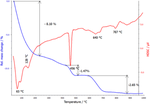JMST Advances Pub Date : 2020-05-18 , DOI: 10.1007/s42791-020-00031-7 Guy Molay Tchapga Gnamsi , Luc Leroy Mambou Ngueyep , Marius Foguieng Wembe , Jean-Marie Bienvenu Ndjaka

|
This paper presents an experimental study of the microstructure of concrete using crushed sands and river sand. Three sands with different geological nature have been investigated in this work. Sand from crushed basalt (SB), sand from crushed gneiss (SG) and sand from river Sanaga (SS) were used for the formulation of these concretes. The results of the analysis show that concrete made from alluvial sand (BSS) has very good compressive strength (33.72 MPa at 28 days) followed by concrete made with crushed basalt (BSB), (33.59 MPa at 28 days) and finally concrete made from crushed gneiss (BSG) (29.83 MPa at 28 days). The same result is also obtained with splitting strength. X-ray diffraction (XRD), enthalpy thermal analysis (HDSC) and thermogravimetric analysis (TAG) were also used to identify physical, chemical and mineralogical behavior of microstructure of various concrete. From the XRD analysis, it was noted that crushed sand gneiss (BSG) contain biotite and amphibole which could justify its poor compressive strength of BSG concrete. Enthalpy thermal analysis (HDSC) and thermogravimetric analysis (TAG) reveal that all concrete could be used in the structure at elevated temperature.
Graphic abstract
中文翻译:

以碎玄武岩、碎片麻岩、冲积砂为细骨料的水工混凝土微观结构分析
本文对碎砂和河砂混凝土的微观结构进行了实验研究。这项工作对三种具有不同地质性质的砂进行了研究。这些混凝土的配方使用了碎玄武岩砂 (SB)、碎片麻岩砂 (SG) 和萨纳加河砂 (SS)。分析结果表明,由冲积砂 (BSS) 制成的混凝土具有非常好的抗压强度(28 天时为 33.72 MPa),其次是由碎玄武岩 (BSB) 制成的混凝土(28 天时为 33.59 MPa),最后是由碎片麻岩 (BSG)(28 天时 29.83 MPa)。劈裂强度也得到相同的结果。 X射线衍射(XRD)、热焓分析(HDSC)和热重分析(TAG)也被用来识别各种混凝土微观结构的物理、化学和矿物学行为。从X射线衍射分析可以看出,碎砂片麻岩(BSG)含有黑云母和角闪石,这可以证明BSG混凝土的抗压强度较差。焓热分析(HDSC)和热重分析(TAG)表明所有混凝土都可以在高温下用于结构。


















































 京公网安备 11010802027423号
京公网安备 11010802027423号